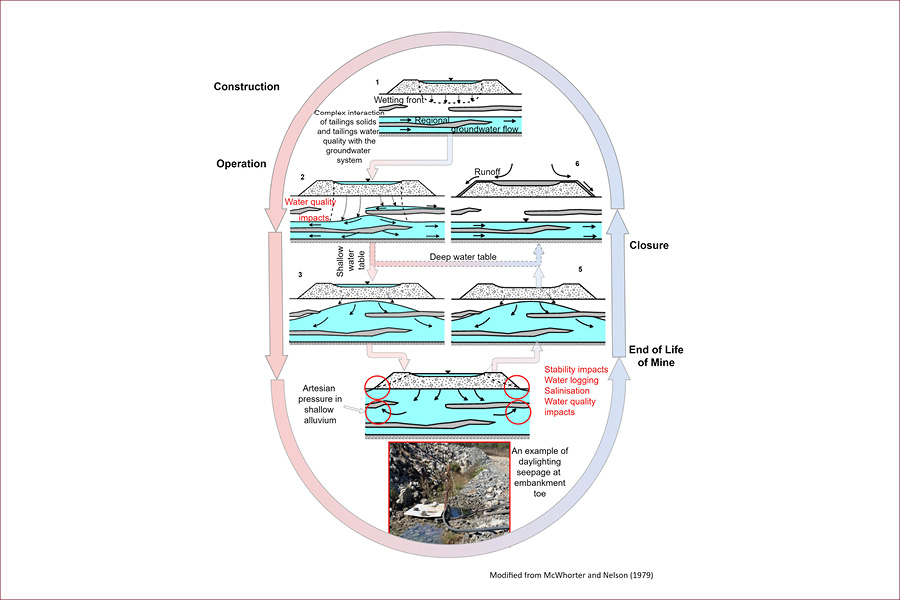By Freeternity Rusinga
Introduction
Common causes of Tailings Storage Facilities (TSFs) failure include slope instability, earthquake, overtopping, foundation failure due to seepage or piping of solid materials through the dam foundation, and mine subsidence. The majority of failures occur as a result of the presence of water. Seepage damage is the leading cause of safety incidents at TSFs. The severity of seepage damage is linked to the interaction of the tailings solids, tailing water quality and groundwater system and seepage control measures. A good understanding of hydrogeology at local and regional scale is important in tailings engineering to reduce design risk and optimise the TSF operational lifecycle. This article provides an overview of key hydrogeological considerations in the design of TSFs.
Industry Best Practice
The Global Industry Standard on Tailings Management (GISTM) provides an overarching best practice framework for the safe management of TSFs. It outlines fifteen Principles that cover six Topic Areas. Most of the engineering is encapsulated in Principle 5:
Develop a robust design that integrates the knowledge base and minimises the risk of failure to people and the environment for all phases of the tailings facility lifecycle, including closure and post-closure.
The requirements for the characterisation of design parameters are expressed in Requirement 2.2 of Principle 2:
Prepare, document and update a detailed site characterisation of the tailings facility site(s) that includes data on climate, geomorphology, geology, geochemistry, hydrology and hydrogeology (surface and groundwater flow and quality), geotechnical, and seismicity.
Tailings Engineering Hydrogeology
Water is unique due to its incompressibility and the near absence of shear strength. In itself, it is a challenging substance when considering the safety of the water storage facilities. A consequence of these properties is water’s ability to transmit and exert high forces that penetrate extremely small crevices. As a result, the impact of seepage from TSFs is inevitable regardless of the liner system applied.
Even with well designed and built conventional liners, some leakage will undoubtedly occur due to pinholes resulting from manufacturing defects and porosity in the material itself. Leakage through holes left during installation and faulty welding are all risks that may be faced in HDPE or bituminous liners. Furthermore, the quality of liners deteriorates over time, and this affects their long-term effectiveness. Hydrogeological risks associated with TSF seepage are connected to impacts on groundwater levels, leading to stability risks or the deterioration of environmental water quality.
It is essential to have a clear and quantitative understanding of the interactions between the TSF and the natural groundwater system to reduce design risk and uncertainty. Hydrogeology for tailings engineering design is a product of the complex interaction of tailings and several natural elements, including climate, geology, geomorphology, and topography. Hydrogeological Conceptual Modelling (HCM) is used to identify key hydrological processes that control the nature of the tailings groundwater interaction. Numerical modelling is performed based on the HCM to simulate the interactions. If an impact has occurred, mathematical modelling can quantify the extent of the impact and provide a simulation for the potential mitigation measures as part of the facility’s design.
Critical to hydrogeological systems is the temporal behaviour, which can express itself as seepage or groundwater level variations within the vicinity of a TSF.
Hydraulics of TSF Seepage
Crucial to this work is understanding and describing the processes underpinning the generation of seepage from a TSF. The mechanism for seepage generation is well documented; however, seepage volume and location is a function of design and setting. A pictorial illustration in the diagram below describes the key stages in the development of mounding beneath a TSF. During the construction phase, unsaturated flow dominates.
The permeability of the footprint varies with moisture content and is low at reduced moisture content while reaching its maximum value when fully saturated. In deep water table aquifers, with thick unsaturated zone, the saturated wetting front may not reach the water table depending on the relative permeability of the tailings/liner, foundation properties and the aquifer. In shallow water table aquifers, mounding may occur, with a possibility coalescing of the downward moving saturated seepage front with the upward moving water table depending on the transmissivity of the aquifer.
Once a fully saturated footprint and linkage between the aquifer and TSF phreatic occurs, fully saturated conditions dominate. This is generally observed during the operational phase of the mine but could extend beyond mine life into closure. In closure, a likely separation between the TSF and groundwater system could result in preferential seepage pathways or a reduction in water transfer from the facility into the aquifer system.

ATC Williams provides an integrated team of TSF designers, including groundwater specialists, to ensure that the critical role of hydrogeology is addressed through the life of mine. Part of the hydrogeological services provided by ATC Williams includes drilling supervision, borehole design, downhole survey, permeability and pumping test analysis, and groundwater modelling.
Key Contacts
Freeternity Rusinga, Principal Engineer on 0423405894 or via email FreeternityR@atcwilliams.com.au
Gideon Steyl, Principal Engineer on 0424974473 or via email GideonS@atcwilliams.com.au